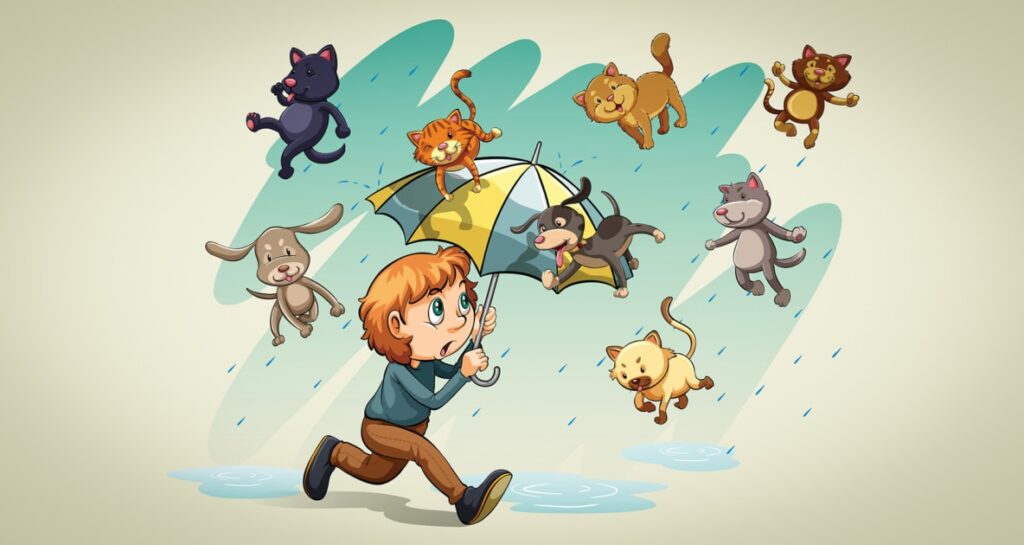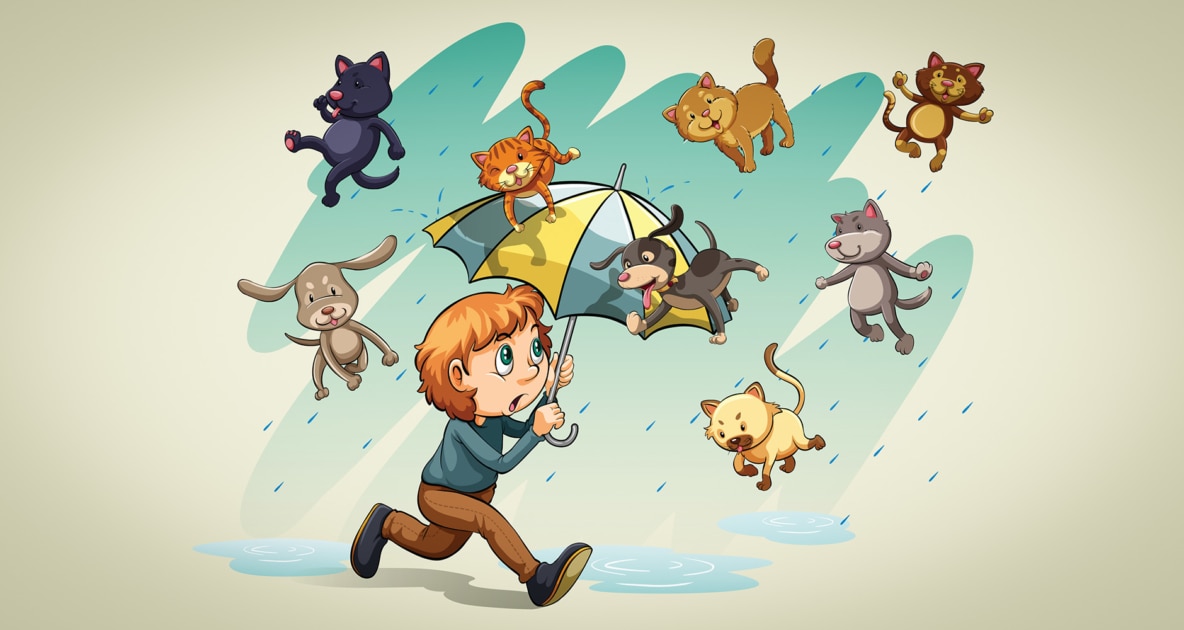
Is It Really Raining Cats and Dogs? Unpacking the Idiom’s Meaning and Origins
The phrase “raining cats and dogs” is a common idiom used to describe very heavy rain. But have you ever stopped to wonder where this bizarre expression comes from? No, it doesn’t literally mean that animals are falling from the sky! This article delves into the meaning, origins, and usage of the idiom “raining cats and dogs,” providing a comprehensive understanding of this colorful expression.
What Does “Raining Cats and Dogs” Mean?
The idiom “raining cats and dogs” simply means that it is raining very heavily. It’s a vivid and often humorous way to describe a downpour. The phrase emphasizes the intensity of the rain, suggesting that it’s coming down with considerable force and volume. When someone says, “It’s raining cats and dogs outside,” they are not being literal; they are using a figure of speech to convey the severity of the weather.
Tracing the Origins: Where Did This Idiom Come From?
The exact origins of the idiom “raining cats and dogs” are shrouded in mystery, and there are several theories attempting to explain its etymology. Let’s explore some of the most plausible explanations:
Theory One: Medieval Housing Conditions
One popular theory suggests that the phrase originated in medieval England. During this time, houses often had thatched roofs, which provided shelter not only for the human inhabitants but also for animals like cats and dogs. When it rained heavily, the roofs would become slippery, and the animals might lose their footing and fall off, giving the impression that it was “raining cats and dogs.” While this theory is intriguing, there’s limited historical evidence to support it directly.
Theory Two: Norse Mythology
Another theory connects the idiom to Norse mythology. In Norse mythology, cats were associated with witches and storms, while dogs were often linked to the Norse god Odin, who was associated with wind and storms. Therefore, some scholars believe that the phrase “raining cats and dogs” might have originated as a metaphorical reference to a particularly violent storm, invoking these mythological associations.
Theory Three: Literal Interpretation of Poor Sanitation
A more grim theory suggests that the phrase arose from the unsanitary conditions prevalent in earlier centuries. During periods of heavy rain, streets would often flood, carrying dead animals, including cats and dogs. This led to the visual impression that it was, in a sense, “raining cats and dogs.” While this explanation is unpleasant, it reflects the harsh realities of life in the past.
Early Written Mentions of the Idiom
Regardless of its precise origins, the idiom “raining cats and dogs” first appeared in written form in the 17th century. Richard Brome’s play, *The City Wit* (1651), contains the line, “It shall raine dogs and polecats.” However, the more familiar form of the idiom appeared later in Jonathan Swift’s satirical poem, *A Description of a City Shower* (1710), where he wrote of the streets being filled with “drowned puppies, stinking sprats, all drenched in mud, dead cats and turnip-tops come tumbling down the flood.” While not exactly the same, it captures the essence of the saying. It is important to note that Swift’s work is not the first recorded use of the phrase “raining cats and dogs“, but it helped popularize it.
How to Use the Idiom “Raining Cats and Dogs”
Using the idiom “raining cats and dogs” is relatively straightforward. Here are a few examples of how you can incorporate it into your conversations and writing:
- “I was planning to go for a walk, but it’s raining cats and dogs outside!”
- “We had to cancel the picnic because it started raining cats and dogs.”
- “Remember to take an umbrella; it looks like it might rain cats and dogs later.”
The idiom is most effective when used in informal settings or when you want to add a touch of humor or exaggeration to your description of the weather. Avoid using it in formal or technical contexts, where a more precise description of the rainfall might be necessary.
Synonyms for “Raining Cats and Dogs”
While “raining cats and dogs” is a widely recognized idiom, there are several other expressions you can use to convey the same meaning. Here are a few synonyms:
- Pouring rain
- Bucketing down
- Raining pitchforks
- Coming down in sheets
- A deluge
- A torrential downpour
These synonyms provide alternative ways to describe heavy rain without relying on the somewhat bizarre imagery of “raining cats and dogs.”
Why Do We Use Idioms?
Idioms, like “raining cats and dogs,” are an integral part of language and culture. They add color, expressiveness, and nuance to our communication. Idioms often carry historical or cultural significance, reflecting the values, beliefs, and experiences of a particular community. They also allow us to convey complex ideas in a concise and memorable way.
Using idioms effectively demonstrates fluency and cultural understanding. However, it’s important to be mindful of your audience and the context in which you’re communicating. While idioms can enhance your communication, using them inappropriately can lead to confusion or misinterpretation. Understanding the idiom “raining cats and dogs” is a good way to understand the history of language.
The Enduring Appeal of “Raining Cats and Dogs”
Despite its strange imagery, the idiom “raining cats and dogs” has remained a popular and enduring expression for centuries. Its longevity speaks to its effectiveness in conveying the intensity of heavy rain. The phrase’s whimsical and slightly absurd nature also contributes to its appeal, making it a memorable and engaging way to describe the weather. The saying “raining cats and dogs” is used across the globe.
The idiom continues to be used in modern literature, film, and everyday conversation, demonstrating its continued relevance and cultural significance. So, the next time you hear someone say it’s “raining cats and dogs,” you’ll not only understand what they mean but also appreciate the rich history and cultural context behind this peculiar phrase. You might even see it raining cats and dogs yourself!
Understanding the cultural and historical background of idioms enriches our understanding of language and society. “Raining cats and dogs” is an example of how history has influenced language.
In conclusion, the idiom “raining cats and dogs” is a colorful and enduring expression used to describe heavy rain. While its exact origins remain uncertain, its meaning is clear: it’s raining very, very hard. Whether you attribute its etymology to medieval housing conditions, Norse mythology, or unsanitary streets, the phrase continues to be a vivid and memorable way to convey the intensity of a downpour. The saying “raining cats and dogs” remains a popular expression.
[See also: The History of English Idioms] and [See also: Common Weather Idioms]

